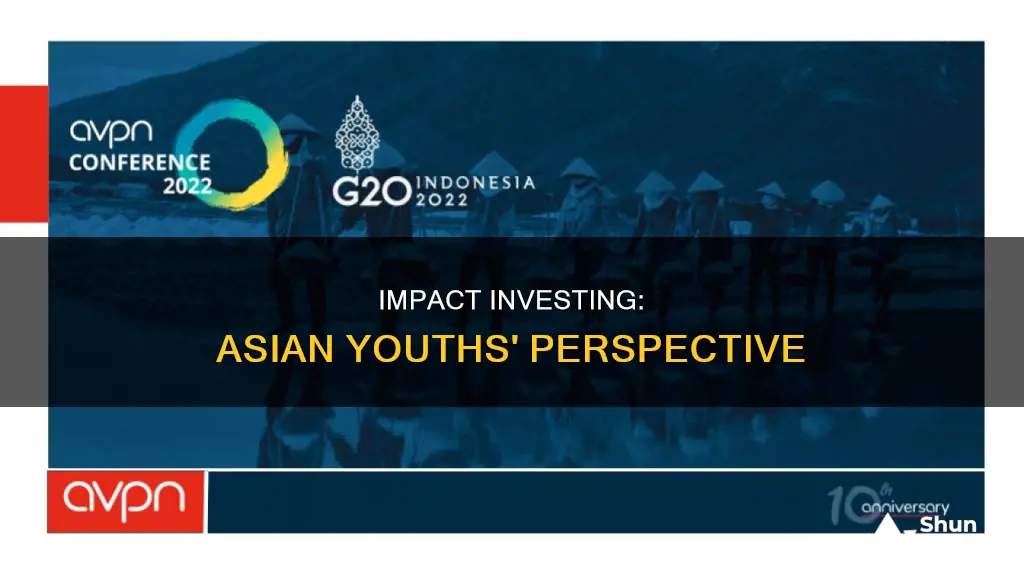
Young people in Asia are witnessing a shift in investment preferences, with a growing interest in impact investing. This trend is particularly notable among millennials and women, who seek to generate positive social and environmental impacts alongside financial returns. Asia has seen a significant increase in impact investing, with investors committing more capital to the region, particularly in Southeast Asia. Young Asians are pursuing impact investing opportunities that make a profit at home, addressing the many socio-economic and environmental challenges within the region. However, impact investing in Asia still faces barriers, including concerns around the identity and nature of impact investing, which can lead to impact-washing and hinder its growth.
What You'll Learn

Young Asians' pursuit of impact investing for profit
Young Asians are increasingly pursuing impact investing for profit, recognising the potential for both financial returns and positive social and environmental impact. This shift is driven by a growing awareness of societal needs and a desire to address them while also generating wealth.
Asia has long been a peripheral player in the impact investment world, despite being home to the most billionaires of any region globally and facing a host of socio-economic and environmental challenges. However, this is changing, with impact investing in eastern and southeast Asia growing by more than 25% over the three years to 2016. Young Asians are key drivers of this shift, with their different outlook on the world and desire to create impact in markets they have a connection to.
The maturing of Asia's relatively young wealth market and the growing influence of the next generation are contributing to the rise in impact investing. Bankers, investors, and experts agree that the opportunity to make money while tackling social and environmental issues is a significant drawcard. Impact investing offers superior returns compared to other regions due to the size of the population and the macro outlook, making it an attractive prospect for young investors.
Young Asians are particularly motivated to address basic infrastructure, education, financial services, and healthcare gaps in markets important to their family businesses. They are also drawn to impact investing by the potential to develop innovative solutions to pressing societal and climate challenges. The recent launch of the Indonesia Impact Alliance and the Women's Livelihood Bond created by the Impact Investment Exchange (IIX) are testament to the growing interest in impact investing among young Asians.
However, challenges remain. There is a lack of clarity around the nature of impact investing, and concerns about "impact-washing" undermining the industry's integrity. Nonetheless, with Asia's diverse economies, rich cultural heritage, and thriving entrepreneurial spirit, it is well-positioned to become a leader in impact investing, and young Asians are at the forefront of this pursuit.
Dogecoin: Worthy Investment or Just a Meme?
You may want to see also

The role of impact investing in addressing societal and climate challenges
Young people in Asia are increasingly interested in impact investing, which is defined by the intention to generate positive and measurable social and environmental impacts, alongside financial returns. This shift in investment preferences is driving the growing demand for impact investing in the region.
Asia has a large number of young people and is home to more billionaires than any other region in the world. Despite this, Asia has not been a significant player in the impact investment world, with only 13% of the $114 billion funding tracked by the Global Impact Investing Network (GIIN) in 2016 going to the region. However, this is changing, and impact investing in eastern and southeast Asia grew by more than 25% over the three years to 2016.
Impact investing can also help develop basic infrastructure, education, financial services, and healthcare in Asia. While addressing global issues like man-made climate change is less of a priority for Asian investors, impact investing can still play a crucial role in this area.
Overall, impact investing has the potential to drive positive social and environmental change in Asia and globally. It offers a way to address societal and climate challenges while also providing financial returns.
Investing in People: Debt as an Asset
You may want to see also

The growing influence of the next generation
Young people in Asia are increasingly interested in impact investing, a trend that is having a noticeable effect on the industry in the region. This interest is driven by a desire to generate positive and measurable social and environmental impacts alongside financial returns.
Asia's rich have historically been peripheral players in the impact investment world, with just 13% of the $114 billion funding tracked by the Global Impact Investing Network (GIIN) in 2016 going to the region. However, this is changing. GIIN's research shows impact investing in eastern and south-east Asia grew by more than 25% over the three years to 2016. This shift is partly due to the growing influence of the next generation, who have a different outlook on the world.
The next generation of wealthy individuals in Asia-Pacific is eager to put their money into impact investment funds. For example, at Credit Suisse, Asia-Pacific clients put $55 million into its first impact investment fund launched in 2016, and they are eagerly awaiting another round. This trend is not limited to one bank; Singapore's DBS, one of Asia-Pacific's largest banks, offered its first impact investment to private banking clients in 2022, who went on to buy 60% of the $8 million Women's Livelihood Bond created by the Impact Investment Exchange (IIX).
The impact investing industry in Asia is still maturing and remains less understood compared to its counterparts elsewhere. However, the growing influence of the next generation is helping to drive the development of the industry and shape its focus.
Investments: Are They for Everyone?
You may want to see also

The potential for impact investing in Asia
Asia has long been a peripheral player in the impact investment world, but this is changing. While the Asian social investment ecosystem is maturing, it is doing so unevenly, and the impact investing industry in Asia is less developed and understood than in other regions. However, the immense potential of Asia as a market for impact investing is becoming clear.
Growing demand
There is a growing demand for impact investing among certain demographic groups, such as women and millennials. This shift in investment preferences is fundamental to the increasing popularity of impact investing. There is also emerging evidence of commercial returns, which boosts the evolution of key ecosystem builders and infrastructure that support the growth of the industry.
A maturing market
Asia's relatively young wealth market is naturally maturing, and the growing influence of a new generation with a different outlook on the world is having an impact. Bankers, investors and other experts agree that the opportunity to make money is a key driver of impact investing's ascendancy in Asia-Pacific. Asia offers superior returns compared to other regions because of "the size of the population and the macro outlook".
Addressing social and environmental issues
Impact investing in Asia has the potential to address pressing societal and climate challenges. There are growing opportunities to support underserved populations, early-stage innovations, and underfunded sectors. Asia is fertile ground for deploying capital towards sustainable solutions, with its diverse economies, rich cultural heritage, and thriving entrepreneurial spirit.
A collaborative approach
The Global Impact Investing Network's (GIIN) recent engagements across the Asia-Pacific region reflect the hard work and perseverance of a range of organisations committed to building the ecosystem across Asia. GIIN has partnered with many of these organisations, including the Impact Investors Council (IIC) of India and the Japanese Financial Services Agency.
The future of impact investing in Asia
While there is a growing appetite for impact investing in Asia, it is still early days. People are receptive to the idea and beginning to experiment, but the floodgates are not yet open. However, with its many untapped opportunities, Asia has the potential to become a much bigger player in the impact investing world.
Military Personnel: Investing for the Future
You may want to see also

The uneven growth of impact investing in Asia
Asia has seen a recent surge in impact investing, with the region's wealthy individuals and businesses keen to channel their money into ventures that promise both financial returns and positive social or environmental outcomes. However, the growth of impact investing in Asia has been uneven, with the industry remaining less developed and understood compared to other parts of the world.
A growing market
Impact investing, which aims to generate measurable social and environmental benefits alongside financial returns, has become increasingly popular among certain demographic groups, such as millennials and women. Asia is home to a large number of billionaires and socio-economic and environmental challenges, yet it has received only a small fraction of global impact investment funding. However, this is changing, with impact investing in eastern and southeast Asia growing by more than 25% between 2013 and 2016.
Overcoming barriers
Despite the growing interest in impact investing, there are still concerns around the identity and essence of the industry. A lack of clarity about the nature of impact investing and the strategies employed can lead to "impact-washing", undermining its integrity. To address these concerns, organisations such as the Global Impact Investing Network (GIIN) and AVPN are working to build the ecosystem and market infrastructure for impact investing in Asia. They are partnering with other organisations and hosting events to foster collaboration, discuss innovative approaches, and share best practices.
Regional differences
While impact investing is growing across Asia, there are regional differences. Indonesia, for example, has a vibrant market for gender-lens investing, with a focus on workplace equity and supporting women-owned or led enterprises. The Philippines, meanwhile, highlights the importance of "microfinance and neo-banking" in facilitating access to finance for women entrepreneurs. Vietnam stands out for having the highest average ticket size investments, showcasing the role of development finance institutions in promoting gender equity in business.
The future of impact investing in Asia
Impact investing is expected to continue growing in Asia, driven by the maturing of the region's wealth market and the influence of a new generation with a different outlook. However, it is important to note that while there is receptiveness to the idea and a willingness to experiment, the floodgates have not yet opened. To fully unlock the potential of impact investing in Asia, it is crucial to address the concerns around the identity and integrity of the industry and clearly demonstrate the potential for market-rate returns.
Black Wealth: Investing Strategies
You may want to see also
Frequently asked questions
Impact investing is defined by the intention to generate positive and measurable social and environmental impacts alongside financial returns.
Impact investing has grown significantly in Asia over the past 15 years. Despite Asia having more billionaires than any other region, it has remained a peripheral player in the impact investment world. However, the latest data shows that the region is now taking impact investing more seriously.
One of the main challenges is a lack of clarity about the nature of impact investing, which has resulted in "impact-washing" and undermined the industry's integrity. Another challenge is that the Asian social investment ecosystem is maturing, but growth is uneven, and impact investing is less developed in Asia compared to the rest of the world.
Young Asians are pursuing impact investing that makes a profit at home. They are motivated to develop basic infrastructure, education, financial services and healthcare in markets that are important to their family businesses.







